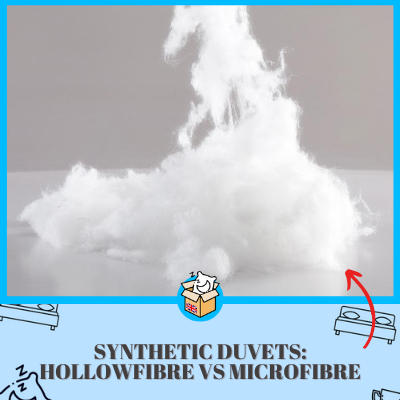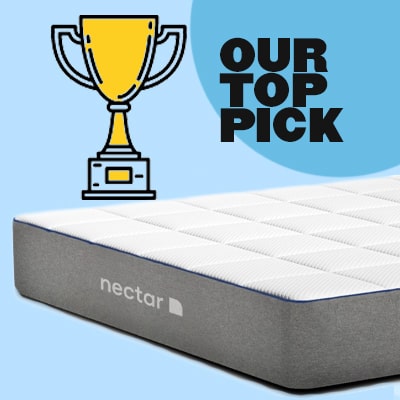Are you about to purchase a new duvet and need some help deciding between hollowfibre and microfibre duvets? Look no further. We have you covered with some great information to help you choose.

We cover:
- Are Hollowfibre duvets warmer than microfibre?
- Which is easiest to clean?
- Are these duvets suitable for kids?
Plus, much more, let’s get into it now.
What’s the difference between hollowfibre and microfibre duvets?
Hollowfibre duvets create warmth by using air trapped between the hollowfibre spaces to create insulation. This is similar to how a feather-down duvet keeps you warm at night.
Hollowfibre is a slightly denser material to work with, but its air-retaining thermal properties feel fluffy and quite luxurious.
Microfibre is a finer denier than hollowfibre, making it feel silky smooth to the touch. For this reason, it is often a substitute for more expensive duvet options in hotels.
The microfibre duvet has a weightier feel which some people like the reassuring comfort while sleeping.
Both hollowfibre and microfibre are synthetic duvets and are machine washable. For larger duvets, it’s best to wash in a laundromat with larger drum sizes.
Are Hollowfibre duvets warm?
Yes, a hollowfibre duvet can be incredibly warm. If you like to feel toasty in bed on those cold winter nights, then the hollowfibre duvet could be the duvet you have been searching for.
The air trapped within the hollow fibres adds additional thermal insulation properties. To be frank, hollowfibre duvets can become overwhelmingly hot if you select a higher tog rating above 10.5.
You will notice your hollowfibre duvet has a lofty sumptuous appearance due to the properties of the hollowfibre.
Are microfibre duvets warm?
Yes, a microfibre duvet is warm and helps regulate your body temperature. Microfibre duvets give a warmth that is controlled due to their breathable material. It’s often considered akin to a more expensive down duvet.
When you sleep under a microfibre duvet, you will first notice that it is a reassuring weight to keep you snuggled up in bed.
The fine denier of microfibre allows the duvet to provide wonderful plumpness while you enjoy the silky smooth texture of the material.
Unless you are an aficionado of fine duvets, you may be mistaken for thinking microfibre is an expensive down duvet!
Are hollowfibre and microfibre duvets hypoallergenic?
Yes, but both do need freshening up twice a year. Both duvet materials are great for those who suffer from allergies around the house.
However, hollowfibre is less breathable than microfibre duvets, so this could cause a problem with the duvet retaining a small amount of moisture over time which could see moulds growing, which could eventually become sufficient to cause an allergy flare-up.
Duvets can often miss the laundry process, so it’s important to follow the manufacturer’s recommendations for laundering with these synthetic duvets.
What are the benefits of hollowfibre duvets?
There are many benefits to hollowfibre duvets. That’s why they are popular. Let’s take a close look at just some of the benefits of sleeping under a hollowfibre duvet:
- Affordability: Hollowfibre duvets are undoubtedly good value for money and, if laundered and taken care of, will last you many years.
- Easy to maintain: hollowfibre duvets are easy to maintain and wash; what’s more, they are easy to dry, which is always a major consideration when deciding to wash a duvet.
- Durable: hollowfibre is a synthetic material and, as such, can accept a lot of punishment while retaining its thermal properties
- It’s lightweight: If you hate feeling pinned down in bed by your bedding, then hollowfibre is the ideal solution for you.
- Allergen-free: Hollow fibre repels allergens if maintained by the manufacturer’s recommendations.
It’s a great all-around budget duvet.
What are the benefits of microfibre duvets?
Microfibre duvets share some of the benefits with hollowfibre duvets. This is why microfiber is a popular choice for your bed:
- It’s a fantastic value compared with other duvets that give a similar feeling of opulence and comfort.
- It is easy to maintain, as you would expect with a synthetic duvet. It’s machine washable and dries fast outdoors or indoors, don’t tumble dry synthetics.
- Like hollowfibre, microfibre is a durable material, and its woven structure makes for a robust lightweight duvet that can extend many years of service if taken care of
- Microfibre has a reassuring weightiness that could be compared to a down-filled duvet.
- Breathable and hypoallergenic.
- It’s as soft to the touch as down and can be difficult to differentiate between the two duvets.
Exceptional value for money.
Should you use hollowfibre or microfibre duvets for kids?
It depends on age, but it’s a no for infants. Infants should be in a cool sleeping environment. Babies and infants often do not need a duvet; if they do, it should be the lowest tog rating.
Infants sleep hotter than adults, their metabolism is different, and they eat more during the day (more frequently, not the amount), which causes a higher body temperature.
Infants being too hot at night is connected to sudden infant death syndrome (SIDS). Too many layers resulting in overheating can be fatal.
What are the microfibre and hollow fibres made from?
Plastics, such as polypropylene. It may seem amazing how plastics can become so soft to the touch. It’s a useful way of recycling plastic products that would otherwise stay buried in a landfill for eternity or very close to.
But don’t worry, the process had completely sanitised the plastics long before they were used in a duvet.
Which is the best choice for you: hollowfibre or microfibre?
It comes down to personal preference if you consider that both products are priced very similarly. So the price would not be a deciding factor.
Both are equally as good as each other in terms of allergens to prevent you from coughing and sneezing.
Both duvets are warm on a cold night.
So how do you choose? Well, if you prefer lightweight and feeling extra toasty, it must be the hollowfibre duvet.
If you like the feel of luxury and silky smoothness with that extra weight, then it has to be the microfibre duvet.
 Nectar Mattress
Nectar Mattress 


